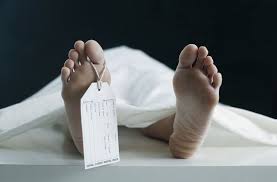 Many crime writers mistakenly believe there’s a precise science to pronouncing time of death (TOD). There is a progressive process, but the sequence and time intervals are influenced by many factors. To craft convincing death scenes, authors need to know how a body actually breaks down.
Many crime writers mistakenly believe there’s a precise science to pronouncing time of death (TOD). There is a progressive process, but the sequence and time intervals are influenced by many factors. To craft convincing death scenes, authors need to know how a body actually breaks down.
Mortis is the anatomical term for changes in a body after the moment of death. Medically, that’s when the central nervous system gets unplugged and oxygenated blood is no longer delivered to the tissues, which naturally start recycling. The five types of mortis are:
-
Rigor – stiffening of muscles
-
Livor – settling of blood
-
Algor – change in temperature
-
Palor – change in color
-
Decomp – breakdown in tissue
 All these mortis conditions are integral to a decomposing process. Death is a part of life and decomposition is a part of death. Just as life is not always predictable, neither is estimating the post-mortem interval (PMI) between when death anatomically occurred and when first examination of the body begins.
All these mortis conditions are integral to a decomposing process. Death is a part of life and decomposition is a part of death. Just as life is not always predictable, neither is estimating the post-mortem interval (PMI) between when death anatomically occurred and when first examination of the body begins.
Death investigations work on a triangle of Body – Scene – History. It’s a holistic approach to determining cause of death (COD) and it’s the coroner’s responsibility to answer five universal questions:
-
Who is the deceased?
-
Where did they die?
-
When did they die?
-
What caused their death?
-
What was the means of death?
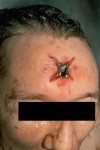 Some people are confused about the difference between cause and means. Cause is the medical reason. In this fellow’s case the cause of death would be traumatic brain injury. Means is the mechanism or physical reason – gunshot wound to the forehead.
Some people are confused about the difference between cause and means. Cause is the medical reason. In this fellow’s case the cause of death would be traumatic brain injury. Means is the mechanism or physical reason – gunshot wound to the forehead.
There can be thousands of causes of death, but there are only five classifications:
-
Natural
-
Accidental
-
Suicide
-
Homicide
-
Undetermined
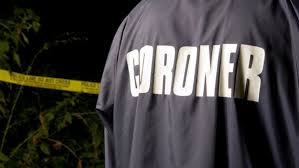 How this ties into mortis is that satisfying the five universal questions, great weight is placed on interpreting the body’s condition when first examined. This is where understanding the mortis process is so important and a lot of the interpretation comes from years of experience.
How this ties into mortis is that satisfying the five universal questions, great weight is placed on interpreting the body’s condition when first examined. This is where understanding the mortis process is so important and a lot of the interpretation comes from years of experience.
The proper pronunciation of the mortis states puts emphasis on the first syllable and it’s a long ‘I’ (RYE-gore).
Let’s look at each one.
Rigor Mortis is the stiffening of muscles. It’s caused by the body’s energy source, adenosine triphosphate (ATP), being depleted. With no energy left to keep the muscles flexible, they naturally go to a rigid state until another enzyme begins the breakdown of tissue and relaxation returns.
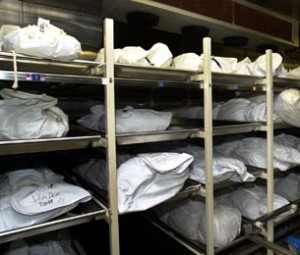 Immediately upon death, the body enters a brief period of primary flaccidity where it’s dead limp. Depending on many factors, temperature and body mass being the big ones, the muscle stiffening begins in 1- 2 hours, first setting into the eyelids, jaw, and neck. It proceeds to the limb joints and extremities after 4-8 hours and fixes in the organs in about 12 hours. Rigor releases in a reverse sequence and can be absent in as little as 12 hours or can stay for days, again depending on factors.
Immediately upon death, the body enters a brief period of primary flaccidity where it’s dead limp. Depending on many factors, temperature and body mass being the big ones, the muscle stiffening begins in 1- 2 hours, first setting into the eyelids, jaw, and neck. It proceeds to the limb joints and extremities after 4-8 hours and fixes in the organs in about 12 hours. Rigor releases in a reverse sequence and can be absent in as little as 12 hours or can stay for days, again depending on factors.
Livor Mortis is the pooling of blood caused by gravitational settling once the heart stopped pressurizing the vascular system. It’s evident by purplish-red blotching where blood is free to pool and blanched-white where pressure points restrict it. Lividity, as it’s also known, sets in between 30 minutes to 1 hour after death and ‘fixes’ in about 8-12 hours. ‘Fixing’ is the entire settling where blood has coagulated and no longer runs free.
Algor Mortis is the change in body temperature. A cadaver will always achieve ambient temperature, regardless of time. A normal, living human’s core temperature is 36 Celsius (98.6 Fahrenheit) but the scene temperature could be anywhere above or below. In a cold environment, the body will drop to equilibriate. In a hot environment, it will rise. Here’s where so many peripheral factors come into play. Body size. Layered Clothing. Air movement. And the list goes on. A rule of thumb is that a body’s temperaature will change about 1 degree Celsius per hour.
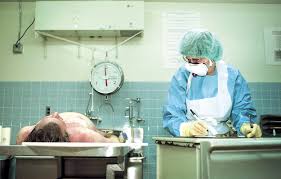 Palor Mortis is the change of color. Live humans are pretty much a reddish tinge due to oxygenated blood flowing (different tones for different races). Immediately upon death, a bluing phase occurs, following by a grey, then a white, and it can be a rainbow of colors as decomposition takes over.
Palor Mortis is the change of color. Live humans are pretty much a reddish tinge due to oxygenated blood flowing (different tones for different races). Immediately upon death, a bluing phase occurs, following by a grey, then a white, and it can be a rainbow of colors as decomposition takes over.
Decomp, or decomposition, is not really a true class of mortis – rather it’s the culmination of the four mortis processes which leads to a breakdown of the body tissues and a return to nature.
Decomposition is a complex and unpredictable thing. There are two processes that morph into one:
-
Putrefaction – action of bacteria on body tissues
-
Autolysis – body breakdown by endogenous substances
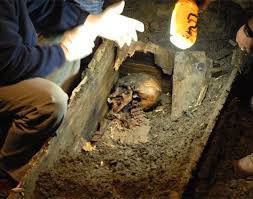 In most deaths these two work in tandem, starting with a breakdown in internal organs which produces gas. This causes bloating and skin discoloring, as well as the foul odor from purging or ‘gassing-off’. As the muscle tissues change, the skin begins to dislodge, the joints become loose enough to disarticulate, fats become liquefied, and bones become exposed. Advanced decomp can become skeletonized, mummified, or consumed – again depending on so many factors, which all start from the mortis process.
In most deaths these two work in tandem, starting with a breakdown in internal organs which produces gas. This causes bloating and skin discoloring, as well as the foul odor from purging or ‘gassing-off’. As the muscle tissues change, the skin begins to dislodge, the joints become loose enough to disarticulate, fats become liquefied, and bones become exposed. Advanced decomp can become skeletonized, mummified, or consumed – again depending on so many factors, which all start from the mortis process.

I just found this post…fascinating as always! Thank you so much for sharing your expertise. I always learn so much from you! (Had no idea before why our visible blood is always red, even from severed veins)
Nice to hear you found this interesting, Carolyn 🙂 Thanks for the feedback!
I found your site because I wanted more information about the death process. My mother passed away recently in her sleep. My sister told me that she was lying on her usual side and looked like she normally did when sleeping except that her nose looked flat. Would her nose look like that because of lividity? Also, they didn’t want her to totally stiffen in that position before the authorities came to the house because they wanted her to be in a lying position, so they laid her out; she was starting to stiffen, so they had just a little difficulty. If she was under the covers, would she have died approximately 4 hours before they found her? My sister kissed her goodnight about 7 hours before, and she did stir so we know that it wasn’t totally at the end of the 4-8 hour window. I do watch crime shows, so I’m probably more curious about my mother’s process than I would otherwise be. By the way, she was 93 and had vascular disease, so that may have altered some of the process.
Hi Donna, Sorry to hear of your loss. There’s no precise time element to how the mortis process unfolds. Temperature and body size are prime factors. What you’re describing sounds normal for an elderly person passing in bed. Muscle stiffing would start about an hour after death in the jaw and neck. After about 3-4 hours, the extremeties would stiffen and full rigor would take place in about 6 hours. Lividity is the settling of blood caused by gravity and it’s evident by a reddish color. Nose flattening is normal when it’s pressed against a solid/semi-solid surface such as a mattress. As a rule of thumb, most 93 year-olds are slight and rigor occurs sooner in the elderly than in younger, heavier people.
Im trying to find a formula or calculation that determines how long the body stays in rogor mortis based on body wieght and or muscle mass – its actually for an Anatomy/physiology course extra credit. Ive looked all over the internet and cant seem to find anything. Can you help me or direct me?
Thanks for commenting, Dana. Unfortunately, there is nothing published that I’m aware of as there’s no consistency to how rigor sets in and how long it lasts. There are too many variables to put an exact framework on rigor. The two main effects are body weight and temperature. Large bodies in warm temperatures tend to have muscle fixing quicker than small, thin one s in cold temperatures. That’s a general rule of thumb as other variables come in like substance ingestion, insulative clothing and physiological/genetic makeup. Then there’s being in direct light/heat vs water immersion and on it goes.
As forensic death investigators, we look at the entire body, scene and history to establish cause and time of death. Rigor is just one piece in the puzzle. I’ve seen rigor set in within an hour on people who we know the exact time of death and then I’ve seen cadavers expired for days still in partial rigor. Babies and small children display very little stiffening as they don’t have much adenosine triphosphate (ATP) in their system – that’s the chemical behind enzyme changes contributing to muscle tension.
I wish I could point you in a black and white direction but I can’t. We know exactly what causes rigor mortis but can only be general about its onset and release. Thanks for your interest and if I can be further help, just shout.
Any comments on the art of plastination? I recently learned what this means.
On another note.. I used to do taxidermy with my dad.
Thanks. Jmelri
I’ve heard about plastination but really don’t know anything about it. Here’s a link to Body Worlds where the developer explains the process: http://www.bodyworlds.com/en/plastination/plastination_process.html
Hi there, I’m starting up research for a novel I’m thinking of writing. It’s fantasy, and thus doesn’t take place in a setting with modern technology/science, but I want my protagonist to be a coroner. She is going to begin investigating bodies that are showing up exsanguinated. I was wondering how the stages of post-death differ for bloodless bodies (who’ve been drained before death, in a way similar to how one might drain an animal of blood in a slaughterhouse). Of course they wouldn’t experience lividity, but would they go into rigor in the same way that a “regular” dead body might? Would it be longer/shorter? Etc. Any info you might have would be greatly appreciated! 🙂
(bear with me, the extent of my knowledge comes from Law & Order!)
thank you!
Hi Alison. In my experience exsanguinated bodies behave no different than regular except for lividity patterns. Lack of blood wouldn’t make any difference on rigor because that’s caused by enzyme action. I’ve never watched any of the CSI type shows but I’d be cautious of how they portray factual forensics. There’s nothing pretty in the death business 😉 Thanks for stopping by & best wishes for your writing!
So, if a body was exsanguinated at the time of death – either before or immediately after – would there be any lividity at all? I’m just wondering if it would actually be possible to drain all the capillaries, etc.?
Hi Kerry. It’s nearly impossible to completely bleed-out a body. Exsanguination is normally voiding the arterial system but the veinous system will still retain some blood. There will always be some lividity patterns but noticably slight when most of the body’s blood is gone. The lividity will tend to be more of a pinkish color and not the purple of an intact body. Hope this helps and thanks for stopping by.
This is an excellent post, Garry, and full of information that’s misrepresented in a lot of murder mysteries, especially on TV. And now I have two other resources 🙂 Aside from the information, the first thing that struck me was how much life is continuing after the human has died–bacteria, enzymes, muscle activity. It shows that the human body and the person inhabiting it do not stand separate from ongoing life. I have a question about blood pooling. Years ago one of our tenants died from natural causes. He’d been dead at least a week before he was found. The blood in his body had settled along his back and legs, then leaked out through the skin, the mattress and was covering the floor. At least that’s how I remember it because of the damage it caused to a large area of flooring. This was a very long time ago, but I still remember the smell. At that time the best way of clearing the air a little was to set cans of coffee grounds on fire. What is that stage of death, how long does it take for something like that to happen, and do you know what compound in the burning coffee mixed with the odors gassing off are that neutralize the smell. Well, now, I just looked at my coffee cup and don’t feel much like finishing it 🙂 Hope you’re having a fabulous weekend.
Hi Cyd! I always appreciate your thoughtful comments and inquisitive mind.
That stage of decomp is called putrefaction and it’s the one that’s associated with the overpowering smell from the gassing off of organic decay. That stage can come within two days if it’s in a hot and confined space and certainly within a week in a normal environment. It’s mostly a factor of body mass and temperature – more fat at a higher temperature will decompose quicker and with more mess than a skinny old guy like me in the cold.
I’ve never hear of the coffee grounds trick. That’s interesting and I’m not sure what’s in there. It might be one VOC (Volitile Orgnic Compound) offsetting another. The only way that I know of to truly eliminate the smell is to remove all contaminated materials and burn it. Some of the big cities have commercial cleaners that specialize in crime scene restoration and I think they use some sort of chemicals. There is one cleaner available that knocks the hell out of animal odours and it might work on human smell. It’s called Nature’s Miracle – http://www.natures-miracle.com/products/pet-odor-stain-removers.aspx
You’re right about the TV shows getting it wrong. People think that every dead body stinks and that’s not true. Recently expired people don’t smell any different from live humans except that most cadavers void because their sphincter muscles no longer hold feces and urine inside. And TV always seems to get the terminology off. I remember one show where one cop told another “Yeah, the ME says death occurred at 12:15 am because his rigger was stiff and his liver was fixed.” 🙂
Ab fab for writers; as a retired nurse I knew a lot of this but it’s wonderfully concise. Thanks for the primer!
Hi Marni and thanks so much for commenting. I’m sure that during your time as a nurse you observed many post mortem changes. They can happen real fast.
Outstanding post, Garry! I’m so glad I decided to read this while I had lunch.
MurderLab.com? Why am I just hearing about this blog? You’ve been holding out on me. 🙂
As far as “cause” vs. “means”, please tell me cops say…”Got COD for me, doc?” And not, “Got means for me, doc?” Because otherwise I may have a panic attack–a major one. Because of your site, I did have the ME test the air as well as the body temp before giving an estimated TOD. Phew! Thankfully, I breezed over the ME’s roll so I wouldn’t complicate my scene. But, I do have another question. If someone is hanging and drained of blood, would there be any lividity? They died from exsanguination. Also, what about someone near death, would their lips turn bluish yet, or no? I’m assuming they wouldn’t “blue” until the body shuts down.
If you don’t mind, I’d love to add a link to this post to my Crime Writer’s Resource so that others can benefit as well.
G’Day Sue 🙂 The cops would never use ‘means’ – it would always be ’cause’ or COD. I’ll bet the vast majority of police officers don’t know that there are two parts to identifying the reason for death, but every ME or Coroner would know this because it’s their mandate to establish the five points. It’s also universal in the civilized world.
In some homicide scenes where TOD is in question we’d bring the pathologist to the scene, if possible, and we’d do an internal temperature measurement right there. We’d make a small incision in the thorax and slip in a probe. Ambient, or air temperature, is always taken at a death scene. It’s as routine as recording the time of arrival and removal.
Good question about lividity in exsanguination cases. There would be very little sign of lividity because most of the blood would be drained, so there’d be little left to pool. It’s difficult to drain all of the blood from the body except in a mortuary during embalming, so there would be some sign, but not much. Blue lips would be a sign of lack of oxygenated blood and could be present prior to death. I’ve seen this in hypothermia cases where the body is sending all the warm blood internally to protect the organs, so the extremeties are suffering from a limited blood supply- so the lips, ears, hands, feet, and genitals turn blue due to a lack of hemoglobin. It’s the same reason why arterial blood is red and veinous blood is blue. Why we never bleed blue from severed veins is that when blood comes in contact with external air it becomes instantly oxygenated.
Glad you found this post useful and by all means share it with as many as possible 🙂